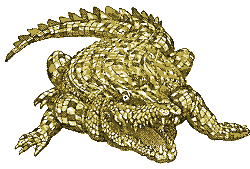| |
|
|
 An Education Kit
for Grades 5 - 7 An Education Kit
for Grades 5 - 7
|
Activity e - Croc shadow puppets
croc appreciation
|
| What you need |
| |
 |
Croc Features Information Sheet (class set) |
| |
 |
Croc Relationships Information Sheet (class set) |
| |
 |
A sheet of fabric or paper and box |
| |
 |
A light source such as torches, overhead projector, candles or lanterns |
|
| |
| |
 |
kitchen implements for puppets |
| |
 |
natural objects for the set |
| |
 |
objects for music and percussion |
| |
 |
ideas for a croc shadow play and an audience! |
|
What you do
To prepare the shadow screen
- Make a simple screen by draping a sheet over the front of a table or pegging a sheet over a line. Another way is to make a paper screen by cutting a window section from a large cardboard box (ie. a fridge box) and covering the cut out area with a sheet of butchers paper or litho paper, taping to keep taut.
- Position the screen so that any daylight is behind the screen. You don't need a totally darkened room. Torches, direct sunlight, candles in jars or lanterns can be hand-held behind the screen or fixed on a stand behind and above the puppeteers.
- Overhead projectors are also an excellent source of light. Try placing objects such as coloured cellophane, petri dishes with coloured water or sand onto the light box for special effects. Don't forget that the lightbox gets very hot!
To make shadow puppets
- Any object that blocks the light can make a shadow puppet. Performers' hands, face and body silhouettes make excellent instant puppets or they can form part of the set.
- Objects such as kitchen implements can be used. Tongs make great crocs; scissors can be flying birds and pegs make baby crocs.
- Natural objects such as driftwood; grasses; leaves can be pegged or held in place to create the set for the shadow play. These designs can alternatively be cut out of card and pegged in place.
To make sounds
- Create sounds for the different animals, the ocean, the river and the shoreline by pouring water into a dish, hitting rocks, rattling stones, rustling leaves, brushing paper and plopping mud. You can also make sounds with your voice and bodies.
- Use these sounds to create a sound-scape with insects, frogs, birds and croc communicating with each other.
- The storyteller could stand in front of the screen with the musicians sitting in the front also.
Shadow plays
- Select an aspect of the crocs life that can be interpreted visually in a puppet play. Some possible topics are suggested below.
- Croc food webs can be enacted. Different animals can be shown by the way they move - slither, stalk, crawl, swim, slide, fly, hop and rap. Each animal can have a different sound. The interactions between each animal (ie. a story of 'who eats who') can be built up visually by encounters between animals.
|
- Aboriginal stories about the croc can be acted out with puppets. The stories can be accompanied by narration, clap sticks, chanting and songs.
- Crocodile behaviour can also be depicted by telling about a day in the life of a croc. Cover the bottom of the screen in tissue or gauze to create the underwater section of the river and the above- water section.
Cut out silhouettes of the rocks and mangroves to create the set. Include croc behaviour such as hunting, nesting and sunbaking into your story.
- Perform your puppet shadow play to the rest of the class, to other classes, your parents or at local fairs or shows.
|
 |
| |
|
 |
© Copyright 2000
Marine Education Society of Australasia
Wildlife Preservation Society of Qld |
|
 |
|
|
|
|
|